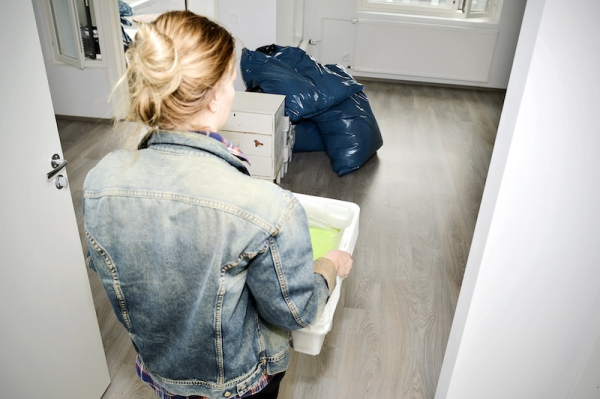
A woman carrying a moving box in Helsinki. Photo: Aku Häyrynen / Str / Lehtikuva
- Next Article Mother and children to be deported to Italy after months in Finnish custody
Student housing in the Helsinki region remains fully occupied ahead of a major change in financial support that will reduce benefits for more than 150,000 students from August.
The Finnish government is shifting students from the general housing allowance scheme to the student-specific housing supplement. The change will lower monthly payments for many and shorten the support period.
According to the Helsinki Region Student Housing Foundation (Hoas), demand for apartments has remained steady despite the upcoming reductions.
“Demand hasn’t increased this year,” said Saara Saksanen, communications manager at Hoas. “When there’s already strong pull to the capital region and high need for student housing, migration patterns don’t affect us much.”
The Ministry of Education has estimated that around 156,000 students will see a reduction in support. In the capital region, the maximum housing supplement will be €296 per month, nearly €100 less than the upper limit of the current general housing allowance. It also applies only during periods when students are eligible for study grants, typically beginning in September.
The announcement of new university admissions peaks in June and July, which is when most housing applications are submitted. Usage rates for student flats hit 100 percent at the start of the academic year, Hoas reports.
Over time, occupancy gradually declines as apartments become available. Hoas expects to release around 3,000 rental units between August and September, all of which are expected to be taken by new students.
Despite earlier predictions, the shift in benefits has not led to a noticeable change in the type of accommodation students are applying for. Last year, Hoas CEO Matti Tarhio suggested that the cuts might increase demand for shared flats, but this has not materialised. Applications for studios and shared units have remained at previous levels.
“When money gets tight, students seem to cut costs in other areas first. Or they take on more work to maintain their living standards,” Saksanen said.
Still, she warned that the full impact may not yet be visible. The housing benefit change could start to affect occupancy later in the year. She said this was already reflected in last year’s data, where fewer students moved out over the winter months.
“With less income, people are more hesitant to move. The threshold gets higher,” she said.
Hoas is also preparing for a possible rise in payment defaults.
“That’s what we fear most,” Saksanen said. “It’s distressing to see students struggle, especially when rents are already low and problems still arise.”
The supplement varies depending on the location and housing costs. In high-cost areas like Helsinki, the capped amount leaves many students needing to cover larger shortfalls.
Despite these pressures, the preference for studio apartments remains strong. Saksanen said that while students appreciate privacy and quiet, few are seeking city-centre units. Most applicants prioritise moderate space in well-connected areas that allow easy access to their institutions.
HT
- Next Article Mother and children to be deported to Italy after months in Finnish custody
Source: www.helsinkitimes.fi
